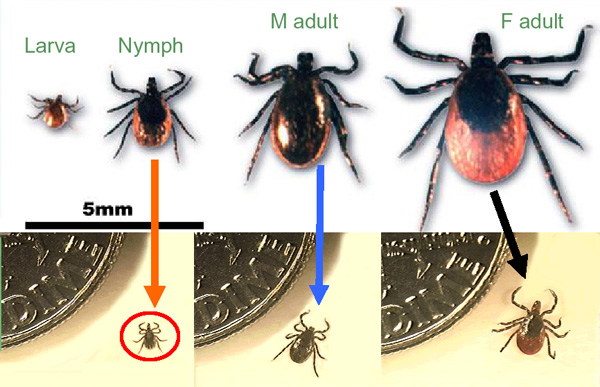Save That Tick! – It Can Be Tested for Lyme Disease
By Chris Williams on February 22, 2013.
Just because it’s almost winter, don’t think that you’re safe from deer ticks and the diseases that they transmit. In fall, the most common stage seen is the adult tick which remains active all winter, seeking blood from deer (or you, if you’re handy). Deer ticks don’t hibernate; they are not killed by frost or cold. Deer ticks remain active all winter unless they are covered by snow. This is not good news since the deer tick is the tick that transmits the three most common diseases in our Northeast region: Lyme disease, anaplasmosis, and babesiosis. The University of Massachusetts Extension Service may be able to offer some peace of mind if you, or a loved one, have been bitten by a tick. In cooperation with the University of Massachusetts Laboratory for Medical Zoology, the Extension Service operates a diagnostic lab that will identify a tick specimen and tell you whether or not that tick that you pulled off is a deer tick (also known as a black-legged tick). The lab can also determine whether or not the tick carried Lyme disease, and can test for several other diseases as well. About 30% of the ticks tested at the lab carry the pathogen for Lyme disease. In addition, about 10% carry the bacterium that transmits anaplasmosis , and 5% carry the organism for babesiosis. 
How to Remove a Tick
If you find an attached tick, remove it as soon as possible since the longer the tick is attached, the greater the chances that a disease will be transmitted. The proper way to remove the tick is to grab it as close to your skin as possible with a pair of fine-tipped tweezers. Slowly, but firmly, pull straight up until all parts of the tick are removed. Wash your hands and the bite site with soap and water. To save the tick for identification, place it in a small zip-lock bag with a small piece of moistened paper towel. Note the date removed, how long the tick was attached, and where the tick up picked up (if you know). If your tick specimen is found to carry Lyme disease, it doesn’t necessarily mean that the disease was transmitted to you or your family member. Ticks usually have to be attached for several hours in order to transmit disease, and even then, it’s not a sure thing. The value of the diagnostic test is that it tells you whether or not you need to watch for symptoms of Lyme disease as a result of that tick bite. You should discuss any positive results with your physician. The tick diagnostic lab opens the mail every Tuesday and begins analyzing ticks that afternoon. They send out results at the end of the week. The lab asks that you use their online tick submission form and follow the instructions there for mailing the specimen, although they say they can still analyze even smashed and dried out ticks. There is a $40 fee per tick specimen.
For more information, visit www.umass.edu/tick or phone 413-545-1055.
Also see: Worried About Tick Diseases? There’s a Test For That